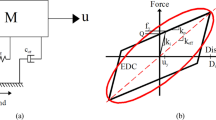Abstract
Seismic behaviors of base-isolated structures are highly affected by the nonlinear characteristics of the isolated systems. Most of the currently available methods for the identification of nonlinear properties of isolator require either the measurements of all structural responses or the assumptions of the proper mathematic models for the rubber-bearings. In this paper, two algorithms are proposed to identify the nonlinear properties of rubber-bearings in base-isolated buildings using only partial measurements of structural dynamic responses. The first algorithm is applicable to the case that proper mathematical models are available for the base isolators. It is based on the extended Kalman filter for the parametric identification of nonlinear models of rubber-bearing isolators and buildings. For the general case where it is difficult to establish a proper mathematical model to describe the nonlinear behavior of a rubber-bearing isolator, another algorithm is proposed to identify the model-free nonlinear property of rubber-bearing isolated system. Nonlinear effect of rubber-bearing is treated as ‘fictitious loading’ on the linear building under severe earthquake. The algorithm is based on the sequential Kalman estimator for the structural responses and the least-squares estimation of the ‘fictitious loading’ to identify the nonlinear force of rubber-bearing isolator. Simulation results demonstrate that the proposed two algorithms are capable of identifying the nonlinear properties of rubber-bearing isolated systems with good accuracy.
Similar content being viewed by others
References
Buckle I G, Mayes R L. Seismic isolation history, application and performance—a world view. Earthquake Spectra, 1990, 6: 161–201
Buckle I G. Passive control of structures for seismic loads. In: Proceedings of the 12th World Conferences on Earthquake engineering. Auckland: Wellington, 2000. 2825
Loh C H, Weng J H, Chen C H, et al. System identification of mid-story isolation building using both ambient and earthquake data. J Struct Control Health Monit, 2011, doi:10.1002/stc.479
Naeim F, Kelly J M. Design of Seismic Isolated Structures: From Theory to Practice. 1st ed. Hoboken: John Wiley and Sons, 1999
Ozbulut O E, Bitara M, Hurlebaus S. Adaptive control of base-isolated structures against near-field earthquakes using variable friction dampers. Eng Struct, 2011, 33: 3143–3154
Pan P, Ye L P, Shi W, et al. Engineering practice of seismic isolation and energy dissipation structures in China. Sci China Tech Sci, 2012, 55: 3036–304
Ismail M, Rodellar J, Ikhouane F. Seismic protection of low-to moderate-mass buildings using RNC isolator. J Struct Control Health Monit, 2012, 19: 22–42
Saiful Islam A B M, Raja R H, Mohammed J, et al. Non-linear time domain analysis of base isolated multi-storey building under site specific bi-directional seismic loading. Automat Constr, 2012, 22: 554–566
Furukawa T, Ito M, Izawa K, et al. System identification of base-isolated building using seismic response data. J Eng Mech-ASCE, 2005, 131: 268–275
Nagarajaiah S, Sun X H. Response of base-isolated USC hospital building in northridge earthquake. J Struct Eng, 2000, 126: 1177–1186
Chaudhary M T A, Abe M, Fujino Y, et al. System identification of two base-isolated bridges using seismic records. J Struct Eng, 2000, 126: 1187–1195
Yin Q, Zhou L, Wang X M. Identification of hysteretic model of rubber-bearing based on sequential nonlinear least-square estimation. Earthq Eng Eng Vib, 2010, 9: 375–383
Kerschena G, Wordenb K, Vakakis A F, et al. Past, present and future of nonlinear system identification in structural dynamics. Mech Syst Signal Pro, 2006, 20: 505–592
Lee Y S, Vakakis A F, McFarland D M, et al. A global-local approach to nonlinear system identification: A review. J Struct Control Health Monit, 2010, 17: 742–760
Ye M, Dou S G, Zhang W, et al. Nonlinear identification of systems with parametric excitation. Sci China Tech Sci, 2011, 54: 2080–2089
Masri S F, Sassi H, Caughey T K. Nonparametric identification of arbitrary nonlinear system. J Applied Mech, 1982, 49: 754–767
Masri S F, Caffery J P, Caughey, T K, et al. A general data-based approach for developing reduced order models of nonlinear MDOF systems. Nonlinear Dynam. 2005, 39: 95–112
Hernandez-Garcia M R, Masri S F, Ghanem R, et al. A structural decomposition approach for detecting, locating, and quantifying nonlinearities in chain-like systems. J Struct Control Health Monit, 2010, 17: 761–777
Ni Y Q, Ko J M, Wong C W. Nonparametric identification of nonlinear hysteretic systems. J Eng Mech, 1999, 125: 206–216
Xu B, He J, Masri S F. Data-based identification of nonlinear restoring force under spatially incomplete excitations with power series polynomial model. Nonlinear Dynam, 2012, 67: 2063–2080
Xu B, He J, Rovekamp R. Structural parameters and dynamic loading identification from incomplete measurements: Approach and validation. Mech Syst Signal Pr, 2012, 28: 244–257
Feldman M, Bucher I, Rotberg J. Experimental identification of nonlinearities under free and forced vibration using the hilbert transform. J Vib Control, 2009, 15: 1563–1579
Hoshiya M, Saito E. Structural identification by extended kalman filter. J Eng Mech, 1984, 110: 1757–177
Kettle P, Murray A, Moynihan F. Sensor less Control of a Brushless DC motor using an Extended Kalman estimator. In: Proceedings of PCIM’98 Intelligent Monitoring. Nuremberg, 1998. 385–392
Yang J N, Pan S W, Huang H W. An adaptive extended kalman filter for structural damage identification II: Unknown input. J Struct Control Health Monit, 2007, 14: 497–521
Author information
Authors and Affiliations
Corresponding author
Rights and permissions
About this article
Cite this article
Lei, Y., He, M. Identification of the nonlinear properties of rubber-bearings in base-isolated buildings with limited seismic response data. Sci. China Technol. Sci. 56, 1224–1231 (2013). https://doi.org/10.1007/s11431-013-5196-3
Received:
Accepted:
Published:
Issue Date:
DOI: https://doi.org/10.1007/s11431-013-5196-3




